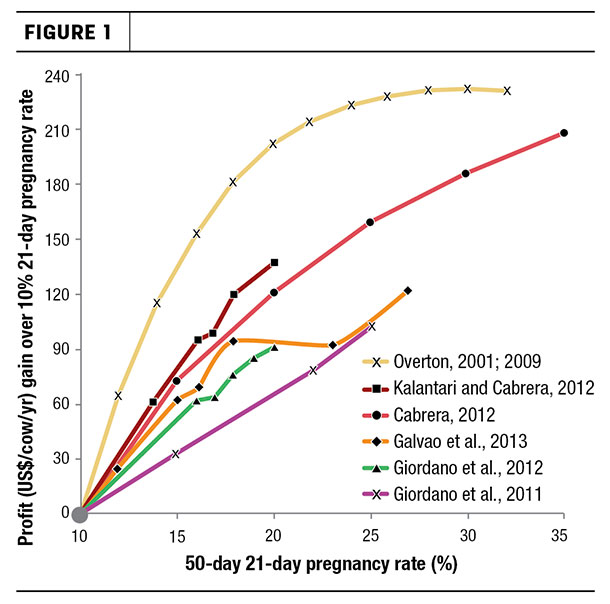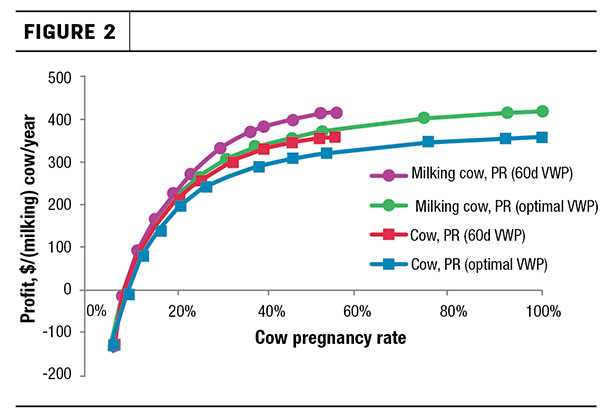Pregnancy rate is a standard measure of the success of a dairy reproductive program. It is the percentage of females eligible to become pregnant in a 21-day period that actually become pregnant. The good news is that average pregnancy rate (PR) has been increasing again over the last decade.
As of September 2016, Dairy Records Management Systems (DRMS) in Raleigh, North Carolina, reports a 19 percent current average herd PR for 7,032 Holstein farms that participate in the DHIA program. It’s becoming more common for herds to achieve a PR in the upper 20 percent range and surpass 30 percent.
But what PR benchmark should dairy farms target?
Optimal factors
The ideal PR for your dairy requires thought and evaluation – the optimal PR is one that best meets your farm’s objectives, such as maximized profitability.
To begin, consider how you determine which cows are eligible for breeding. Should cows be inseminated as soon as possible after calving, or is a delay of first insemination better for your herd? How long is the insemination window for open cows?
Also consider the cost to achieve an improved PR. What can your farm afford to spend to obtain a greater PR? And how will your dairy manage the increased ability to get cows pregnant when desired? Will you sell surplus heifers or remove more cows from the herd?
Cost of high PR
A review of published research shows that higher PR has been associated with greater profitability, but profits increase less when PR is already high. No published studies show that even greater PR may result in diminished profitability. It is necessary, however, to review the assumptions in these studies.
For example, the greater PR may only be achievable at a high cost in labor, technology or both.
Therefore, the question is, “Does the economic value of the greater PR outweigh the cost to create it, especially with a traditional 50- or 60-day voluntary waiting period (VWP) before first insemination for all cows?”
Also, consider the timing of “eligible to become pregnant,” because getting females pregnant sooner is not necessarily better for every group of cows. An increased PR means you need to rethink the VWP when cows become eligible and how long to continue rebreeding open females.
The value of calves also affects the importance and best timing of getting cows pregnant.
PR data in high-performing herds
According to DRMS records for 7,032 Holstein herds, 11 percent of herds had a PR between 28 and 39 percent. These herds accounted for 21 percent of the cows and, overall, a higher PR tendency was detected in larger herds.
Herds with greater PR also had:
- Shorter average days in milk
- Longer VWP but shorter days to first service
- Greater service rates
- Fewer days open
- Shorter calving intervals
- More calvings per cow per year
Age at first calving was a little younger in herds with greater PR, too.
These data also show herds with greater PR had both cows and heifers with greater genetic merit as measured by the average predicted transmitting ability for Net Merit. Average annual milk yield per cow increased slightly.
PR profitability
The value of improved reproductive performance – as measured by PR – comes from many factors that are never all included in a financial (modeling) analysis.
The main factor is shorter average days in milk, and therefore, greater feed efficiency and greater milk income over feed cost. Other factors typically included are number of calves born, reproductive culling and breeding costs. As a result, price differences for milk income over feed cost, replacement cost and breeding cost affect the value of a greater PR.
Figure 1 shows how an increased PR is associated with increased profit per cow per year for six recent U.S. modeling studies.
 Each study reported profit at different PR. The gains in profit are a mixture of net gains that include the cost of the technology to achieve that change in PR and gross gains that do not include the cost to obtain the change in PR.
Each study reported profit at different PR. The gains in profit are a mixture of net gains that include the cost of the technology to achieve that change in PR and gross gains that do not include the cost to obtain the change in PR.
Still, in all studies, greater PR leads to greater profit. Even in the two studies that report PR over 30 percent, profit keeps increasing. However, there is no economic optimal PR.
The value of increasing PR, though, is diminishing in at least two of the studies. These lower marginal returns at greater PR are expected. It is typically assumed in these studies that better reproductive performance leads to less reproductive culling and therefore, lesser annual culling rates, which in return mean a lower herd replacement cost.
In five of the six studies, the annual culling rate decreases when PR increases because fewer cows are removed for failure to get pregnant on time. Further, the number of dairy calves born in the herd and the number of heifers needed to replace culled cows are assumed to be independent.
Keep in mind, extended days open may increase the risk of overconditioning of cows toward the end of their lactation because milk yield is then typically lower while feed intake is less reduced. Analyses show an association between longer days open in the previous lactation with increased risk of culling in the next lactation.
An extra day open in the first parity costs approximately an extra 22 cents due to greater risk of culling in the next lactation. For older cows, it is 33 cents because of greater risk of death and culling. This means the marginal value of an increased PR is a few dollars more than estimated before when the effects of overconditioned cows are ignored.
Pregnancy rate definition and measures of profitability
The data in the chart do not show a decrease in profit with greater PR.
The studies generally use a definition of PR that starts with a VWP of 50 or 60 days. This means the denominator (females eligible to become pregnant) assumes cows should get pregnant, but there is some evidence that the VWP can be extended in some situations when PR increases.
Therefore, an alternative definition of PR starts counting eligible females when they are (economically) eligible to get pregnant. Essentially, cows are not eligible when inseminations are voluntarily delayed.
Analysis with the DairyVIP simulation and optimization program investigated how profit and both definitions of PR change in a herd of cows when the inputs of 21-day service rate and conception risk are increased simultaneously. These increases are assumed to be free.
The chart in Figure 2 shows results for one set of inputs. You can see profit continues to increase with greater PR using both PR definitions (60-day VWP or optimal VWP).

The increase does diminish, however, with greater PR.
Secondly, the increase in profit is greater for a small change in PR defined as starting at 60-day VWP compared with a small change in PR calculated with the optimal VWP. Also, profit per milking cow increases more than profit per cow when PR increases.
This is true for both definitions of PR. Lastly, there is a shortage of dairy heifer calves when PR is low and an increasing surplus when PR is greater.
Reproductive performance was changed without additional cost. In reality, there are expenses to improve reproductive performance.
You could spend the difference in profit between two levels of PR to obtain that change in PR. For example, to move from 22.8 percent PR to 26.2 percent PR (60-day VWP), the profit per milking cow per year changes by $35. Any expenses less than $35 per milking cow per year to move PR to 26.2 percent would result in a net gain.
This analysis, like the analyses in the previous chart, assumes the use of only conventional semen; genetic progress is not included and all calves are sold and heifers purchased.
The benefits of increasing PR will depend on what is being done with the heifer calves.
Using an economic analysis featuring six scenarios, the most profitable strategy depended on the level of reproductive performance. These data indicate there is a strong interaction between level of PR and the most profitable strategy.
When PR increases, the strategy may need to be adjusted to capture the most value. For example, raising all heifers and thereby increasing cull rate of cows was less profitable than a strategy where the lowest-ranking heifers were sold at an early age.
Ultimately, it is clear the value of increased PR goals depends greatly on decisions to keep or sell dairy heifer calves, including the value of their genetics. Increased cost to obtain the greater reproductive efficiency may – or may not – make a greater PR economically beneficial. ![]()
This information was presented at the 2016 Dairy Cattle Reproduction Council Annual Meeting.

-
Albert De Vries
- Associate Professor
- University of Florida Department of Animal Sciences





